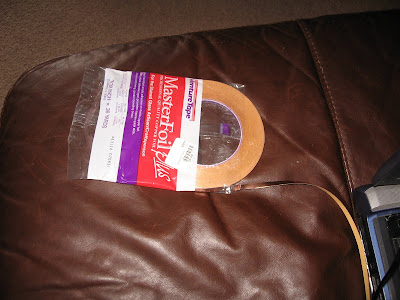
The first thing is to place copper foil tape around each piece. The foil tape has a copper outside and various colors on the "sticky" side. On glass that is not transparent, it is ok to use tape that is copper on both sides. (It is also cheaper!) On glass that is transparent, like the orange stripes on the cat, I used tape that is black on the sticky side because the solder will be blackened and you will be able to see the tape through the glass.
 Here you can see the tape around a piece of glass. You can also see the grain in this piece. After the tape is applied to the edge, it is folded over onto the front and back of the piece. It is then pressed into place by a piece of plastic called a fid.
Here you can see the tape around a piece of glass. You can also see the grain in this piece. After the tape is applied to the edge, it is folded over onto the front and back of the piece. It is then pressed into place by a piece of plastic called a fid. The pieces have been foiled and have been fitted together
The pieces have been foiled and have been fitted together
The joints are painted with a chemical called "flux." This is an acid that cleans the metal and allows the solder to flow. But at this point, a small blob of solder is placed on all the joints just to hold them together. This is called "tack soldering."

The pieces have been soldered together. A wire was also soldered around the outside edge to give the piece greater strength. After all the solder joints have been completed, the flux is washed off with a special soap.

This is where the magic happens! A patina is added to the lead solder that turns it black. Not only does the patina make the solder lines stand out, it also helps to hide any mistakes. The black lines act similar to the black outlines in cartoons. By making the lines black, they, in effect, disappear from consciousness. This is also the reason I used a tape with a black back on the transparent pieces. If you can see the tape through the glass, it will just blend into the solder line. Different patinas can be used to change the solder copper or to keep it silver.

I then painted irises into the eyes and added toes to the paws and whisker marks on the upper lip. For all intents and purposes, the clock is done at this point. The only thing that is missing is the clockworks.

2 comments:
I have to agree that the hands need to be replaced with bigger (longer) ones and that black would be a better choice for visibility. But you have a very nice finished product and I appreciate the walk-through.
And I appreciate it the more because, through the process, I did not have to use even one single band-aid! ;)
Wow! very cool! Looks great!
Post a Comment